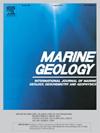泥沙沉降速度的智能预测:采用可解释的机器学习和量化环境因素的影响
IF 2.2
3区 地球科学
Q2 GEOSCIENCES, MULTIDISCIPLINARY
引用次数: 0
摘要
粘性泥沙絮凝形成的絮凝体沉降速度受湍流剪切、盐度、悬沙浓度和泥沙粒径等水文因素的显著影响,是评价河口海岸带泥沙输运的关键参数。由于复杂的河口动力学和技术限制,现阶段泥沙絮凝体原位沉降速度的测量和预测具有挑战性。迫切需要一个强大的、可解释的预测模型。为了满足这一要求,我们提出了一种新的可解释机器学习(ML)模型预测沉降速度的新范式,该模型将ML与Shapley加性解释(SHAP)相结合,使用4个水文参数作为独立输入特征。采用了8种ML算法(包括最近提出的XGBoost、LightGBM等)和集成学习(Stacking),并使用贝叶斯优化算法确定超参数。在8个基本学习器中,XGBoost模型在6个性能指标方面具有最高的预测精度。这些模型的叠加优于每个组件模型。利用强大的SHAP方法,所提出的范式能够解释/解释ML模型的预测,并从局部和全局的角度突出沉积物动力学系统的高度影响特征。此外,开发的ML模型提供了对每个特征的贡献的透明见解,而不会影响预测的准确性。这些基于ml的模型优于传统的修正Stokes定律或经验方程。特别地,将物理信息神经网络(PINN)用于絮凝体沉降速度的预测,这也是克服数据驱动模型黑箱特征局限性的有效方法。将ML与物理定律和SHAP相结合,可以成为研究泥沙输运的有力工具。本文章由计算机程序翻译,如有差异,请以英文原文为准。
Intelligent prediction of sediment floc settling velocity: Employing explainable machine learning and quantifying the impacts of environmental factors
Settling velocity of flocs resulting from cohesive sediment flocculation, significantly influenced by hydrological factors (e.g., turbulence shear, salinity, suspended sediment concentration and sediment size), is a key parameter to evaluate sediment transport in estuarine and coastal ocean. Measurement and prediction of in-situ settling velocity for sediment flocs are challenging at current stage due to the complex estuarine dynamics and technique constraints. A powerful and interpretable prediction model is urgently required. To meet this requirement, we propose a new paradigm in predicting settling velocity with interpretable machine learning (ML) model by combination of ML with Shapley additive explanation (SHAP) using 4 hydrological parameters as independent input features. Eight ML algorithms (including recently proposed XGBoost, LightGBM and so on) and ensemble learning (Stacking) were employed, with Bayesian Optimization Algorithm to determine the hyper-parameters. XGBoost model was found to have the highest prediction accuracy in terms of 6 performance metrics, among the 8 base learners. Stacking of these models outperform each component model. With the powerful SHAP methods, the proposed paradigm is able to interpret/explain ML model predictions and highlight the highly influential features for the system of sediment dynamics in both local and global points of view. Additionally, the developed ML model provides transparent insights into the contribution of each feature without compromising predictive accuracy. These ML-based models outperform conventional modified Stokes law or empirical equations. Specially, physics-informed neural network (PINN) is employed for prediction of floc settling velocity, which is also a useful approach to overcome the limitations of data driven model characterized by black box. Combinations of ML with physical law and SHAP, the key of the proposed paradigm, could be very powerful tool for researchers on sediment transport.
求助全文
通过发布文献求助,成功后即可免费获取论文全文。
去求助
来源期刊

Marine Geology
地学-地球科学综合
CiteScore
6.10
自引率
6.90%
发文量
175
审稿时长
21.9 weeks
期刊介绍:
Marine Geology is the premier international journal on marine geological processes in the broadest sense. We seek papers that are comprehensive, interdisciplinary and synthetic that will be lasting contributions to the field. Although most papers are based on regional studies, they must demonstrate new findings of international significance. We accept papers on subjects as diverse as seafloor hydrothermal systems, beach dynamics, early diagenesis, microbiological studies in sediments, palaeoclimate studies and geophysical studies of the seabed. We encourage papers that address emerging new fields, for example the influence of anthropogenic processes on coastal/marine geology and coastal/marine geoarchaeology. We insist that the papers are concerned with the marine realm and that they deal with geology: with rocks, sediments, and physical and chemical processes affecting them. Papers should address scientific hypotheses: highly descriptive data compilations or papers that deal only with marine management and risk assessment should be submitted to other journals. Papers on laboratory or modelling studies must demonstrate direct relevance to marine processes or deposits. The primary criteria for acceptance of papers is that the science is of high quality, novel, significant, and of broad international interest.
 求助内容:
求助内容: 应助结果提醒方式:
应助结果提醒方式:


